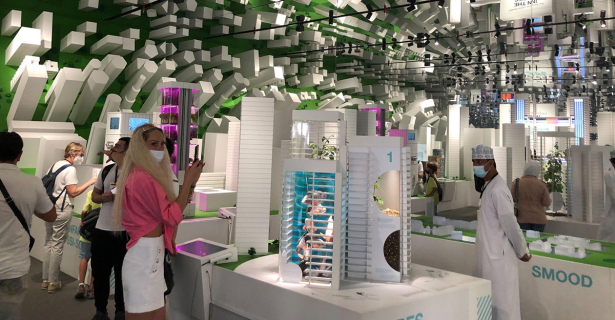As an International Relations and Urban Studies student at Tufts, with an interest in cultivating a career which merges these fields, I was very keen to explore the global innovations in space-making and urbanism which were to be showcased here at the Dubai World Expo. In fact, the event itself was a model, with the Expo’s campus built and styled as a hyper-futuristic city, funded by the prosperity of the UAE. The wealth of the Gulf’s leaders is unfathomable in scale and even more mind-blowing in its applications, whether that be the construction of artificial islands, entire cities risen up out of the desert, map-distributing and facial-mask-ordinancing robots, or cloud-piercing towers. Emirati luxuriance has been on full, impressive display at the Expo, and on my last day I feel almost numb to the amazing infrastructure and architecture that constitutes the physical space of the event. I was hopeful to discover that such wealth and growth could be channeled into innovation, and that Dubai would host a space for a sort of global urban reckoning, asserting the ideals of smart city development in unique, country-specific, and sustainable forms. Undeniably, there was no shortage of countries espousing theories and explaining crises of modern urban development practices. Almost all pavilions acknowledge urbanization as an unstoppable trend, and the international issue of urbanization was one of a few talking points which seemed ubiquitous across all three sectors of the Expo: mobility, innovation, and sustainability. Though too many countries seemed content with simply the acknowledgement of the issue, with vague signs and graphics — many of which read like ‘the world is becoming very urban, there will be problems, the world must come together to address the issue, etc, etc.’ — lacking any concrete solutions or positive ideas, there were several outliers which enlightened me to the possibilities for innovation in this essential field.
 Germany was remarkable in this regard, combining visionary optimism with real examples of new urban tech. Due to the constant sprawl of a line which terminally plagued the German pavilion, I waited until the last day to enter ‘Campus Germany’. When I first walked in, there was a large poster, reading “In 2100, 85% of the population will live in cities. What kind of cities should they be?” Such instigating questions were all over the pavilion and enthralled visitors to actually engage with the expositions. Some examples of German innovations on display were CargoCap, a transporting initiative which mitigates the negative environmental consequences of the trucking industry upon cities by circumventing cargo through underground tunnels (think Elon Musk’s The Boring Company but for trucks), and Lilium Jet, a small electric plane company pioneering innovation in the cutting-edge urban air mobility sector. Another exceptional pavilion in this regard was Bahrain, which definitely asserted a more pathos-based approach in engaging visitors. Bahrain sought to address and manifest, physically, the trend of increasing population density which will confront future cities, which the country views as both a pressing issue but also a “catalyst of opportunity.” The pavilion presented an architectural design of more than a hundred columns spaced around the pavilion, in close, almost erratic proximity, but when combined all supporting the beautiful steel ceiling. Navigating all the columns is challenging and somewhat burdensome but such will be the reality of high-density megacities. To make these places habitable and sustainable, collective cooperation towards greater ends (i.e. holding up the roof) will be a paramount matter of importance. Ultimately, there were so many pavilions which highlighted unique innovations in urban technology, planning, and design, and Bahrain and Germany are just two examples. Leaving the Expo, I feel somewhat hopeful that, even if only a small fraction of these ideas embed themselves in the actual future policies of urban leaders, there exists a definite opportunity and ample motivation, vision, and capability to reinvigorate the cities of the future to be sustainable, equitable, and beautiful.
Germany was remarkable in this regard, combining visionary optimism with real examples of new urban tech. Due to the constant sprawl of a line which terminally plagued the German pavilion, I waited until the last day to enter ‘Campus Germany’. When I first walked in, there was a large poster, reading “In 2100, 85% of the population will live in cities. What kind of cities should they be?” Such instigating questions were all over the pavilion and enthralled visitors to actually engage with the expositions. Some examples of German innovations on display were CargoCap, a transporting initiative which mitigates the negative environmental consequences of the trucking industry upon cities by circumventing cargo through underground tunnels (think Elon Musk’s The Boring Company but for trucks), and Lilium Jet, a small electric plane company pioneering innovation in the cutting-edge urban air mobility sector. Another exceptional pavilion in this regard was Bahrain, which definitely asserted a more pathos-based approach in engaging visitors. Bahrain sought to address and manifest, physically, the trend of increasing population density which will confront future cities, which the country views as both a pressing issue but also a “catalyst of opportunity.” The pavilion presented an architectural design of more than a hundred columns spaced around the pavilion, in close, almost erratic proximity, but when combined all supporting the beautiful steel ceiling. Navigating all the columns is challenging and somewhat burdensome but such will be the reality of high-density megacities. To make these places habitable and sustainable, collective cooperation towards greater ends (i.e. holding up the roof) will be a paramount matter of importance. Ultimately, there were so many pavilions which highlighted unique innovations in urban technology, planning, and design, and Bahrain and Germany are just two examples. Leaving the Expo, I feel somewhat hopeful that, even if only a small fraction of these ideas embed themselves in the actual future policies of urban leaders, there exists a definite opportunity and ample motivation, vision, and capability to reinvigorate the cities of the future to be sustainable, equitable, and beautiful.

